Each question contains statements given in two Columns, wihich are to be matched. Statements in Column-I are labelled as A, B, C and D whereas statements in Column-II are labelled as p, q, r and s. Match the entires of Column-I with appropriate entries of Column-II. Each entry in Column-I may have one or more than one correct option from Column-II. The answers to these questions have to be appropriately bubbled as illustrated in the given example. If the correct matches are A→(q,r),B→(p,s),C→(r,s)andD→(q), then correctly bubbled matrix will look like the following:
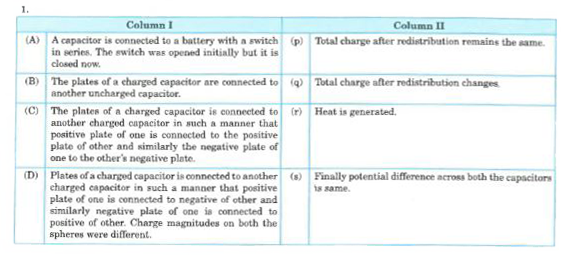
The correct Answer is:A→(r) B→(p,r,s) C→(p,r,s) D→(q,r,s)
A→(r): We know that heat is lost in charging process. And finally potential difference across the capacitor becomes equal to that of battery.
B→(p,r,s): One capacitor is having charge but the other is uncharged so there is no chance of neutralisation of charge so total charge remains unchanged. In the charge redistribution process, heat is generated and both the capacitors acquire a common potential difference.
C→(p,r,s): Plates with similar charges are connected to each other so there is no neutralisation of charge so total charge remains the same. In the charge redistribution process, heat is generated and finally both the capacitors acquire a common potential difference.
D→(q,r,s): Plates with opposite charges are connected to each other so there is neutralisation of charge so total charge does not remain the same. In the charge redistribution process, heat is generated and finally both the capacitors acquire a common potential difference.
Topper's Solved these Questions
- ELECTROSTATIC POTENTIAL AND CAPACITANCE Book:MODERN PUBLICATIONChapter:ELECTROSTATIC POTENTIAL AND CAPACITANCE Exercise:Competition file (INTEGER TYPE QUESTIONS)
Explore 10 Videos
- ELECTROSTATIC POTENTIAL AND CAPACITANCE Book:MODERN PUBLICATIONChapter:ELECTROSTATIC POTENTIAL AND CAPACITANCE Exercise:Competition file (NCERT Exemplar Problems: Multiple Choice Questions Type-I)
Explore 6 Videos
- ELECTROSTATIC POTENTIAL AND CAPACITANCE Book:MODERN PUBLICATIONChapter:ELECTROSTATIC POTENTIAL AND CAPACITANCE Exercise:Competition file (MATCHING TYPE QUESTIONS)
Explore 3 Videos
- ELECTROMAGNETIC WAVESBook:MODERN PUBLICATIONChapter:ELECTROMAGNETIC WAVESExercise:CHAPTER PRACTICE TEST
Explore 14 Videos
- MAGNETISM AND MATTERBook:MODERN PUBLICATIONChapter:MAGNETISM AND MATTERExercise:CHAPTER PRACTICE TEST FOR BOARD EXAMINATION
Explore 16 Videos
Similar Questions
Each question contains statements given in two Columns, which are to be a matched. Statements in Column-I are labelled as B A, B, C and D, whereas statements in Column-II C are labelled as p, q, r and s. Match the entries of D Column-I with appropriate entries in Column-II. Each entry in Column-I may have one or more than one correct option from Column-II. The answers to these questions have to be appropriately bubbled as illustrated in the given example, if the correct matches are A→(q,r),B→(p,s),C→(r,s) and D→(q)

View SolutionEach question contains statements given in two Columns, which are to be a matched. Statements in Column-I are labelled as B A, B, C and D, whereas statements in Column-II C are labelled as p, q, r and s. Match the entries of D Column-I with appropriate entries in Column-II. Each entry in Column-I may have one or more than one correct option from Column-II. The answers to these questions have to be appropriately bubbled as illustrated in the given example, if the correct matches are A→(q,r),B→(p,s),C→(r,s) and D→(q)
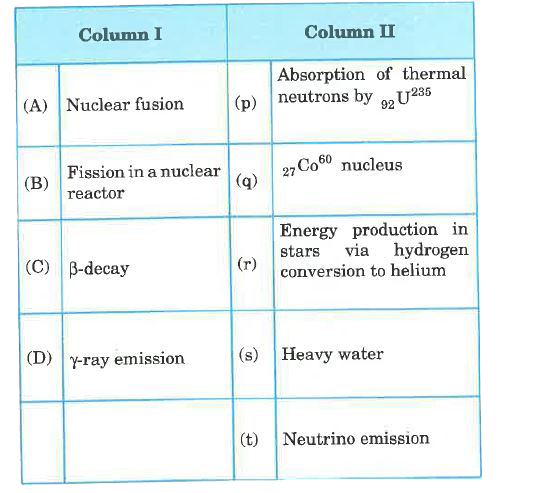
View Solution
Knowledge Check
Each question contains statements given in two columns, which have to be matched. Statements in Column I are labelled as A, B, C and D whereas statements in Column II are labelled as p, q, r and s. Match the entries of Column I with appropriate entries of Column II. Each entry in Column I may have one or more than one correct option from Column II. The answers to these questions have to be appropriately bubbled as illustrated in the following example. If the correct matches are A-4, A-r, B-p, B-, C-r, C-s and D-q, then the correctly bubbled matrix will look like the following:
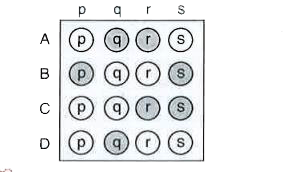
Match the element in column I with the property mentioned in column II
 A(q) , (s)B(p), (q)C(q), ( r)D(p),(q),(s)
A(q) , (s)B(p), (q)C(q), ( r)D(p),(q),(s)
Each question contains statements given in two columns, which have to be matched. Statements in column-I are labelled as A and D whereas statements in column-II CP are labelled as p, q, r and S. Match the entries of DP S column-I with appropriate entries of column-II. Each entry in column-I may have one or more than one correct option from column-II. The answers to these questions have to be appropriately bubbled as illustrated in the given example, if the correct matches are A→(q,r),B→(p,s),C→(r,s)andD→(q).
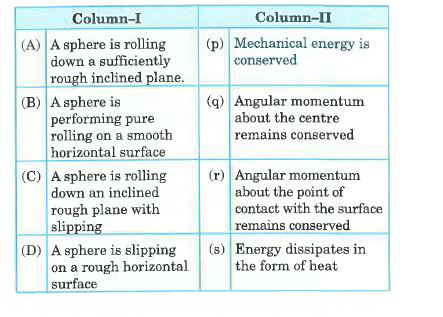
View SolutionEach questions contains statements given in two columns, which have to be matched. Statements in column - I are labelled as A,B,C and D, whereas statements in column-II are labelled as p,q,r and s. Match the entries of column-I with appropriate entries of colomn-II . Each entry in column-I may have one or more than one correct option from column - II. The answers to these questions have to be appropriately bubbled as illustrated in the given example, if the correct matches are A→(q,r),B→(p,s),C→(r,s)andD→(q).
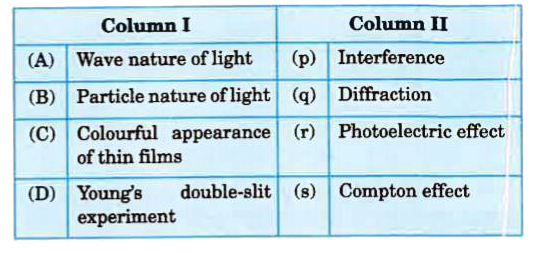
View SolutionEach question contains statements given in two columns, which have to be matched. Statements in Column I are labelled as A, B, C and D whereas statements in Column II are labelled as p, q, r and s. Match the entries of Column I with appropriate entries of Column II. Each entry in Column I may have one or more than one correct option from Column II. The answers to these questions have to be appropriately bubbled as illustrated in the following example. If the correct matches are A-4, A-r, B-p, B-, C-r, C-s and D-q, then the correctly bubbled matrix will look like the following:
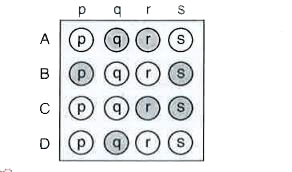
Match the element in column I with the property mentioned in column II
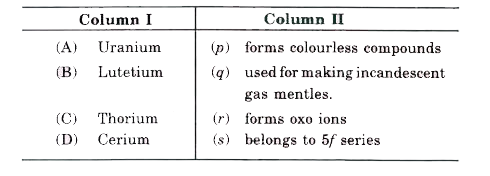
View SolutionEntries of Column-I are to be matched with entrices of Column-II. Each entry of Column-I may have the matching with one or more than entries of Column-II

View SolutionEntries of Column-I are to be matched with entrices of Column-II. Each entry of Column-I may have the matching with one or more than entries of Column-II

View SolutionEntries of Column-I are to be matched with entrices of Column-II. Each entry of Column-I may have the matching with one or more than entries of Column-II

View SolutionEntries of Column-I are to be matched with entrices of Column-II. Each entry of Column-I may have the matching with one or more than entries of Column-II

View Solution

